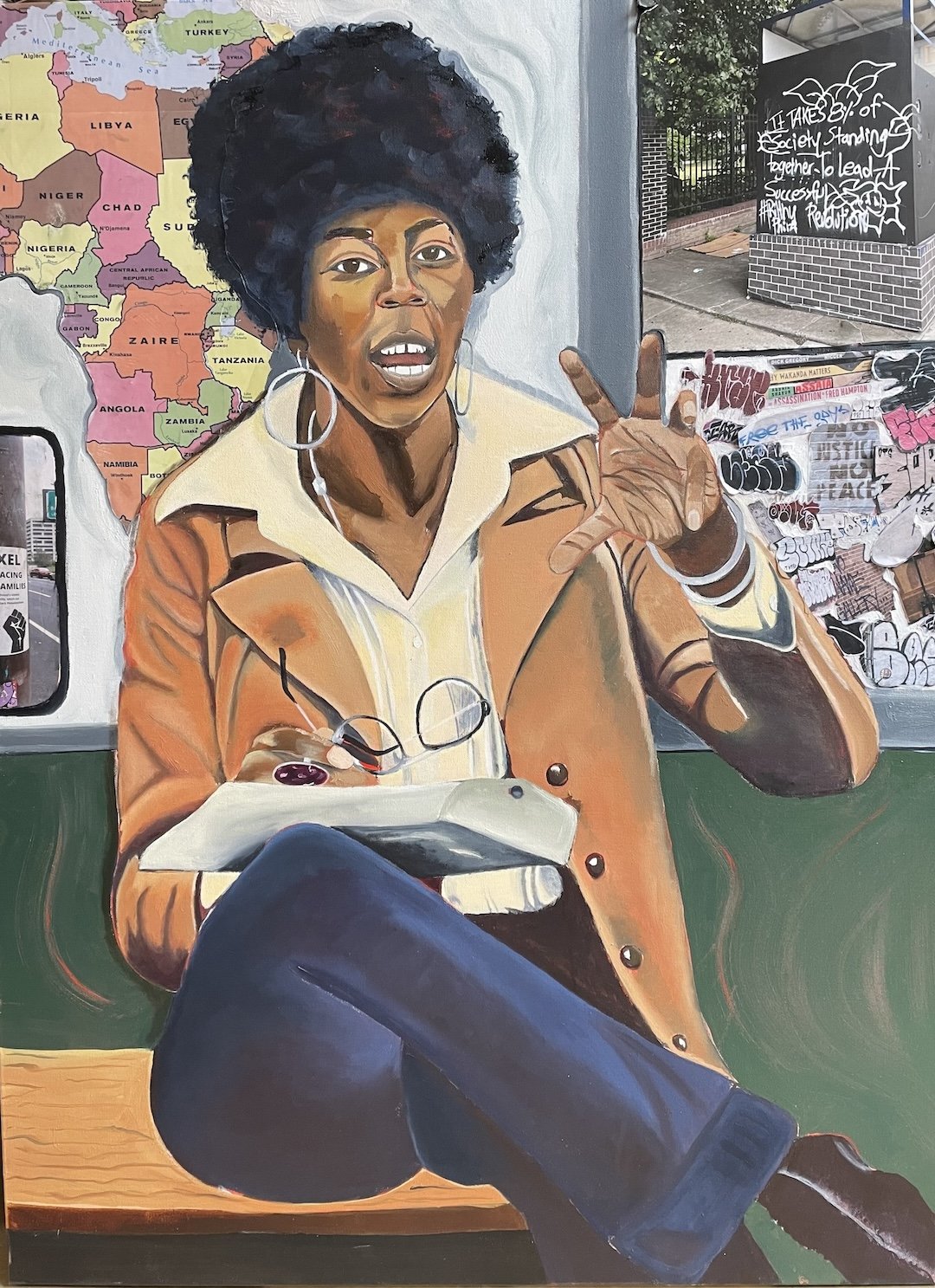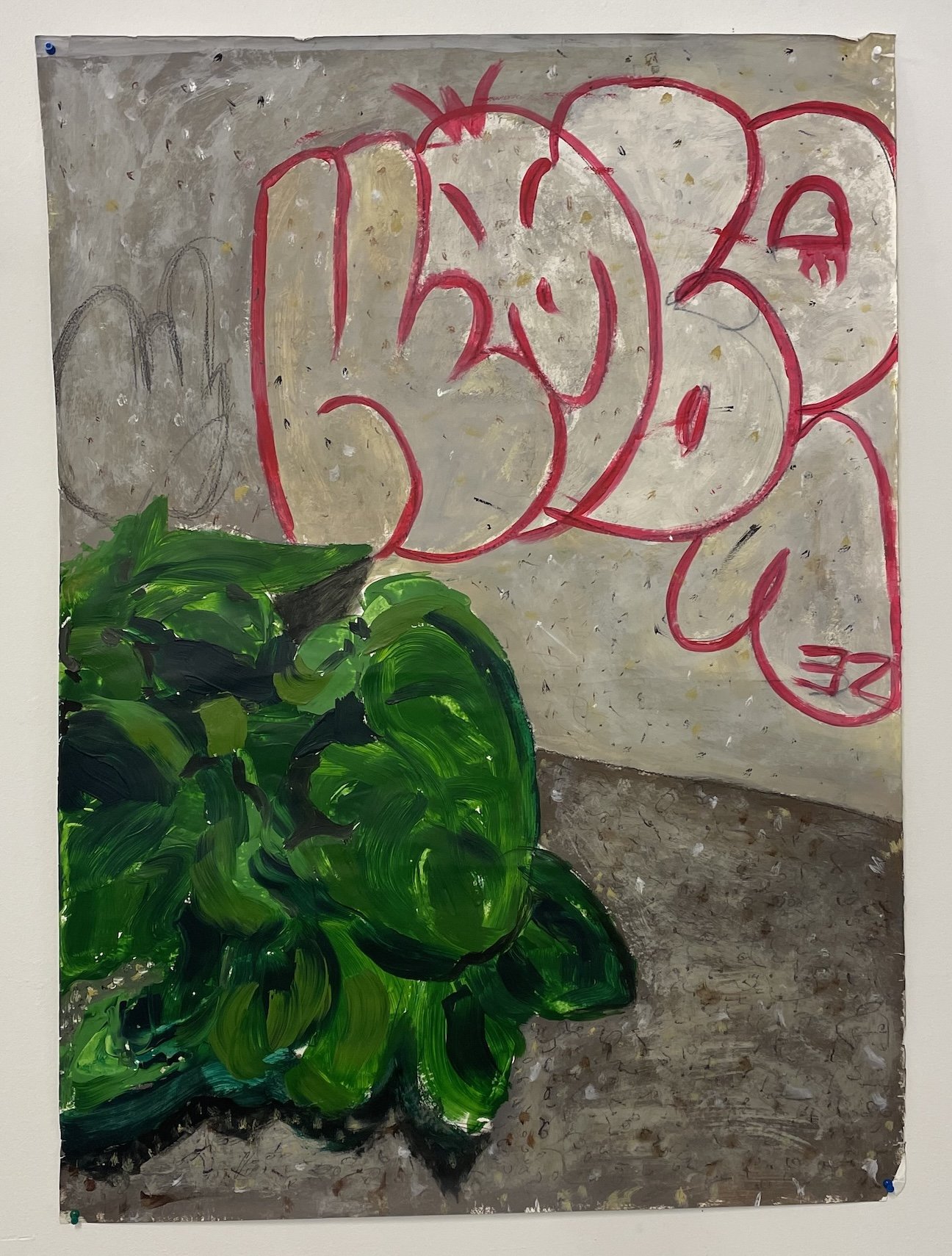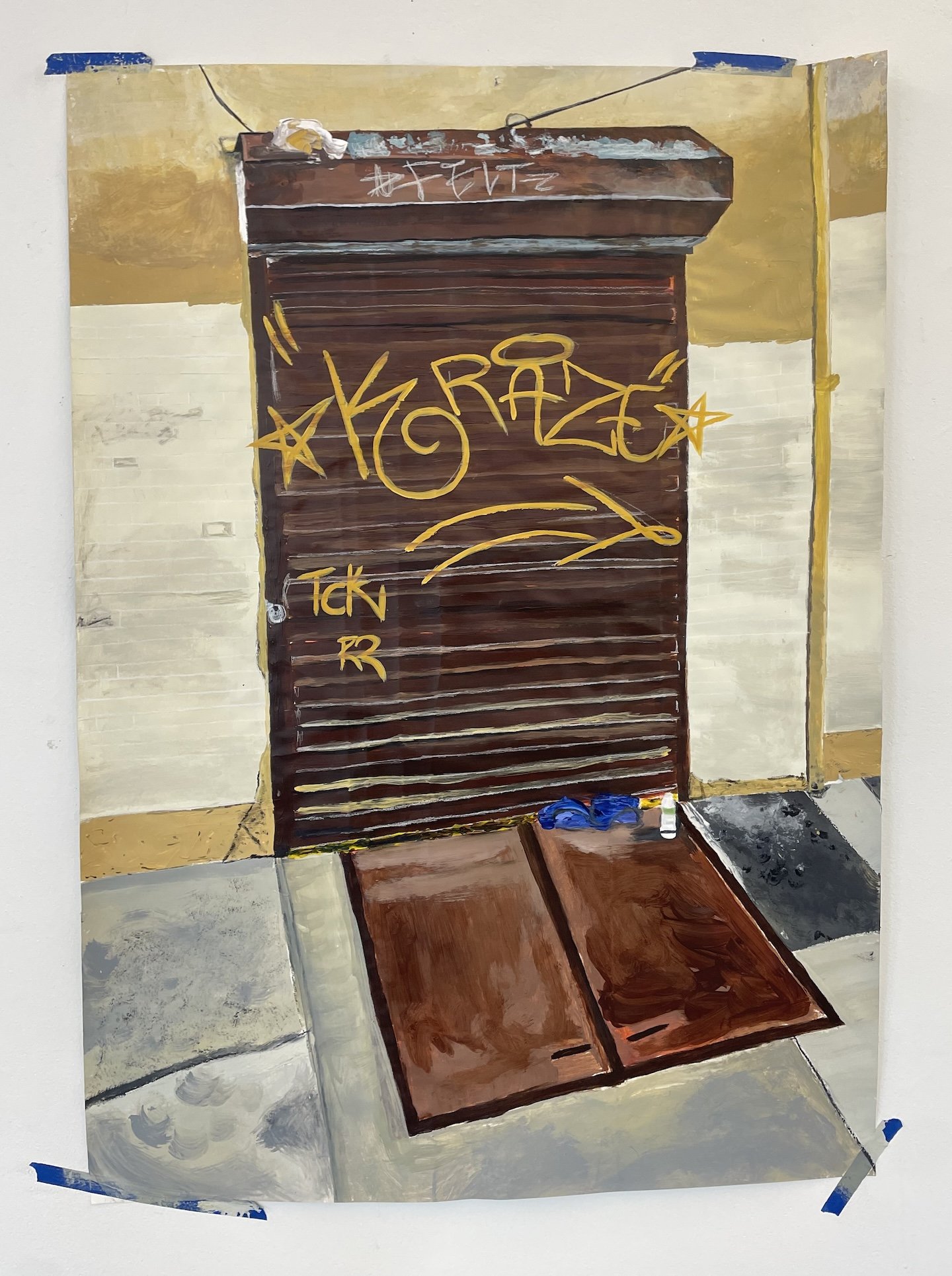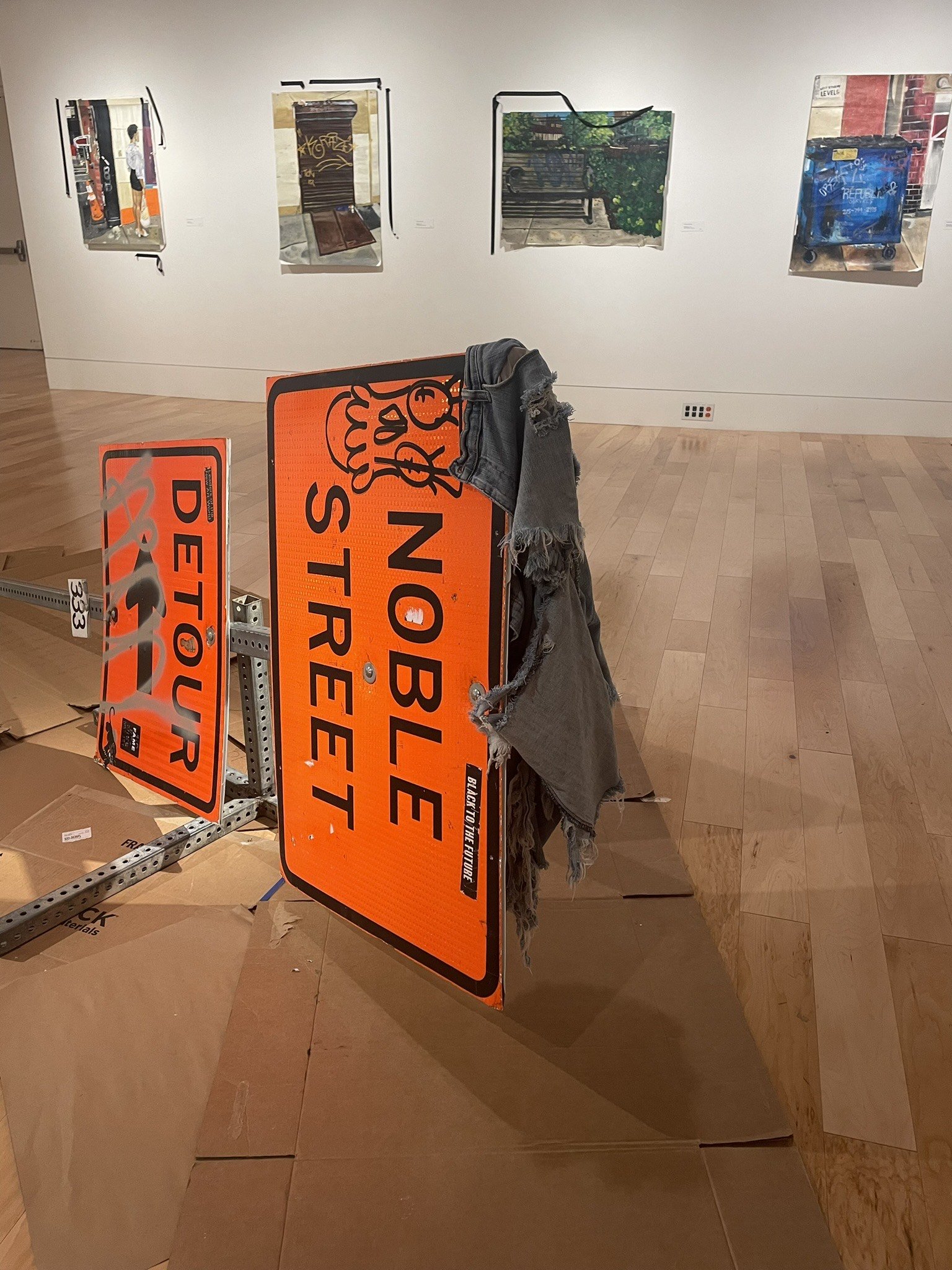Interview with artist Te'Arra Stewart
Te’Arra Stewart is a mixed media artist living in North Little Rock, Arkansas. She earned a BS in Visual Arts from the University of Arkansas Pine Bluff and an MFA from Pennsylvania Academy of Fine Art in Philadelphia. Te’Arra’s work explores her heritage and in many ways is a coming-of-age story of her as an artist. She is a 2024 Mid-America Arts Alliance Arkansas Catalyze Grant recipient and teaches in the Department of Art and Design at the University of Arkansas Pine Bluff. More of Te’Arra’s work can be found at her website tearrastew.art.





AAS: Te’Arra, where did you grow up?
TS: I grew up in North Little Rock on Pike Avenue, so I of course I attended NLR High School. Through a JAG program, which allows students to leave school early to work and organizes field trips to help with job training and career development, I discovered UAPB on a campus field trip. But it was the ‘aggressive nudge’ of my bestie friend and mother that helped me decide to attend college and I picked UAPB and earned my BFA there. I’m currently living in Little Rock and working in Pine Bluff at UAPB.
AAS: Congratulations on your recent MFA from the Pennsylvania Academy of the Fine Arts. What were your experiences like there?
TS: Grad school was mentally straining to be honest. I had a difficult time figuring out why I was making art. I thought for a long time that my reasons weren’t good enough, conceptual enough, or compelling. It really was a fight with myself against my own insecurities. As an undergrad at UAPB, I didn’t fully understand why I was making art. I’m used to being the observer and playing in the background, so to now be the focal point and being forced to dig deep and explain myself was something that I could do but wasn’t fully ready for it. At PAFA I couldn’t hide who I was, it was a necessity to ditch the imposter syndrome. UAPB taught me valuable skills, provided opportunities to go to prestigious schools for internships such as Fisk, Yale, and Princeton, and that connected me with other artists, curators and conservators. I absorbed so much knowledge about art preservation, curation, community development, and art handling. But even those experiences couldn’t fully prepare me for grad school.
I felt extremely isolated initially, but eventually I allowed my vulnerability to drive my work, and I stopped caring about how I was perceived and just let what I needed come to me. Being fairly young, I’ve had to conceptualize things that 30- and 40-year-olds have had more time to consider. I’m grateful to be ahead of the curve as far as thinking critically about things but sometimes it feels like a burden. I truly understand why ignorance is bliss!
I absolutely love Philadelphia! But as I said, being in a new environment completely isolated me and put my survivor skills to use. I would take daily walks in my favorite areas of the city, and I began to meet people that reminded me of classmates or family. I enjoyed the nature and the unique grunge of the city.
AAS: You’ve described your thesis work as discovery of identity. What do you mean by that?
TS: My thesis was titled The Exploration of Identity: Through the lens of Self, Portraiture, Street Art & Gentrification. In this work I was very vulnerable and transparent about my life, experiences, realizations, and discoveries. I didn’t really know what to expect at PAFA and it was initially stressful coming from undergrad and having specific assignments and being graded to being in a program where I was in control and no gradebook was determining my worth or abilities. I was anxious about how my work would be received, but everyone who I spoke candidly with actually understood and resonated with the vulnerability of the work. Through my artwork I’ve quite literally had realizations and epiphanies about understanding my heritage, where I come from, and how my environment and the people in it have shaped me. I’m slowly evolving into what I see best for myself and life. All of those aspects directly impact the development of a person and how we all come to be who we are, and I’m discovering who and what makes me, Te’Arra. I wrote my thesis from that place – in this new city where I was searching for home. As I discovered truths about my bloodline, culture, family, self, and society, I captured what felt like familiar energy through imagery of people, places, and things that made me reflect on what home was.
AAS: I want to ask you first about Thief. Is that work, an encapsulation of your life and life experiences? What does it say about you?
TS: Thief is certainly an encapsulation of my heritage, family, and life’s experiences in Philadelphia that helped shape me. The tag ‘Thief’ is sourced from a graffiti writer in central Arkansas. When I returned from Philadelphia the second summer of my program, I knew I wanted to home in on street art. My awareness for graffiti had been heightened and I noticed graffiti tags more often than usual. I captured a picture of ‘Thief’ written on a corner store at the end of 18th street in North Little Rock. To come home and see that tag helped to convince me to follow my new feelings and interpretations of street art and countercultures. Thief is conceptually a self-portrait. It reflects people, places and things that represent who I am and where I come from.
Thief, mixed media on paper, 30” x 50”
AAS: One of my favorite paintings from your thesis is Wanderer. Why did you choose to depict that image of what I assume is from Philadelphia?
Wanderer, acrylic, sharpie, and graphite on paper, 40” x 32”
TS: Wanderer is an image I captured at a park in downtown Philadelphia. It’s a place I’d go to sit, read, and journal. It made me feel like I was at home, taking a walk on the river downtown. The imagery was comforting and in a way it reminded me of seeing trains passing through with graffiti all over them. Visually, I was fascinated with the juxtaposition of the tag on the bench and the surrounding nature, which in a way complimented its arrogant placement. Conceptually, the painting spoke to exactly where I was in life – sticking out like a sore thumb as the only Black woman in an MFA program at a renowned, predominantly White art institute as well as being in a city that was unfamiliar.
AAS: The influences of urban life and street art in your work are clear. Why do you think you derive such inspiration from that?
TS: Street art is one of my sources of inspiration because that’s where I come from. It’s what I relate to. It also makes me feel comfortable when navigating new cities. The influence of the street art aesthetic was my life growing up on Pike, the inner city of North Little Rock. Graffiti is also one of the five elements of Hip Hop and plays a huge role in Black Culture. Writers like Darryl McCray paved the way for local graffiti writers even more than well-known street artists like Bansky. It is important to say that street art and graffiti are just an avenue for conversation, often misunderstood with an unapologetic presence. It may seem as if that’s the focus solely but it’s not. It’s an avenue to conversations about life, societal norms, countercultures, heritage, history, and experiences of being a Black in America and the interconnectedness of me to all the people, places, and things in life that I encounter. Yes, I’m fascinated with graffiti, but my overall narrative and artist practice is heavily influenced by artists like Kerry James Marshall, Kara Walker, Nick Cave, Jennifer Packer, Jordan Casteel, Bansky, Elizabeth Catlett, Romare Bearden, and Aaron Douglas.
AAS: Gypsy is an extraordinary painting where elements of urban and street life really come through.
Gypsy, acrylic and oil paint on paper, 30” x 24”
TS: Gypsy started as a photograph I captured on my phone of my close friend Imani. We had just had our final brunch before she was departing to move back home. Initially it was just an aesthetically pleasing photograph that was more like a keepsake for me, but after I sat with the image, I realized it fully embodied what I was also experiencing. A nomad in a familiar yet unsettling place, her posture radiating confidence, looking forward to new beginnings and not getting caught up in the past of what could’ve been and instead facing what is. The tags ‘dream’ and ‘love free’ on the infrastructures complimented the narrative of conquering the unknown and of new experiences and discoveries to come. The traffic cone behind her serves as a guard protecting her and initiating caution to those who try to disrupt the journey.
In my paintings I like to intentionally disrupt the “white cube” whether that’s through the use of materials outside the cube or with narrative. Most of my work isn’t on traditionally stretched white canvas and even if it is I find a way to disrupt the confines of the form with tape, markings, untraditional wall colors, etc. My choice in materials also pushes another key narrative of my experiences in life of ultimately creating something out of nothing and working with what I have. Which is what my ancestors have been doing for decades. As I grow in my practice, I will keep that aspect alive – using unconventional materials, making extraordinary work with it, being the one who’s adding value.
“I create art to preserve my heritage and initiate conversations around societal and cultural issues that countercultures and African Americans are experiencing.”
AAS: In your work I see elements of construction counterbalanced by destruction. Is that where you are in your life now or do those images represent a transitioning time?
TS: You’re really clocking my tea! I would say that I’m wading in between the two at all times. I create art to preserve my heritage and initiate conversations around societal and cultural issues that countercultures and African Americans are experiencing. I’m still learning and unlearning flawed characteristics of myself. This imagery came from a transitioning period as well. Like I said, I had an “oh shit, this is who I am this is what I like” moment in grad school. I decided to lean into it instead of abandoning the “ghetto” or “urban” aspects that made me. I recognized who I truly was at my core in a new city. Then I came home and captured local imagery that reflected that as well.
Professor, acrylic and oil on paper, 70” x 24”
AAS: Professor is my most favorite painting. Congratulations on that one! The action, the perspective, the composition all work so beautifully! Tell me about that painting.
TS: Professor actually was a premonition painting in retrospect because I am now one, Ha! Its imagery came from hanging out with my close friend and colleague, Matthew Fields, at Kanis Park in Little Rock. Professor is a painting that could be stereotyped by its skater’s aesthetic and people who come from its counterculture. Just from looking at his tattoos, dirty vans, and skateboard you wouldn’t assume he’s someone very prestigious, an educator, and PhD student. Professor is one of those pieces I made to play with people’s subconscious to see what they’d assume and how they’d engage a conversation about the depiction of a “skater”.
AAS: I have to ask what is it like being an instructor at UAPB and inspiring students who were in your position just a few years ago?
TS: In January 2024 I took a position as Assistant Professor at the University of Arkansas at Pine Bluff in the Department of Art and Design. I still haven’t fully processed being so young and now teaching. I do have a great time and since we have a low student-to-teacher ratio I can build a relationship with my students and help set them up for success. I would say that it’s complex and has moments of being really liberating as well as difficult. It’s much like making art. I find myself enjoying the process more and sometimes the finished piece is everything I’d imagine and sometimes there are aspects that need to be more resolved. I love UAPB. It’s more than just a teaching university. We truly have a close community (some of my colleagues were previously my teachers) and students that are eager. Everyone shares the goal of trying our best to ensure student success.
AAS: Te’Arra, congratulations on being a 2024 Mid-America Arts Alliance Arkansas Catalyze Grant recipient! What does that award mean to you and where do you see yourself and your art in the next five years?
TS: Thank you so much!!!! Being a 2024 recipient of the Catalyze Grant honestly was so reassuring. It’s a practice-based grant funding professional development and coaching to artists of all disciplines in central Arkansas. The grant confirmed for me that I am where I’m supposed to be, doing the work that needs to be done, and most importantly that people actually appreciate my work. I thank The Mid-America Art Alliance and Windgate Foundation for recognizing my artistry and seeing the value in it. This grant has given me a huge boost by funding my art practice, studio, and travel for scholarly research. Within five years, with God’s grace, I hope to be tenured at my university, traveling, exhibiting in regional and national art exhibitions, and establishing a nonprofit specifically for assisting artists on the rise and educating urban communities through art-related programs.


